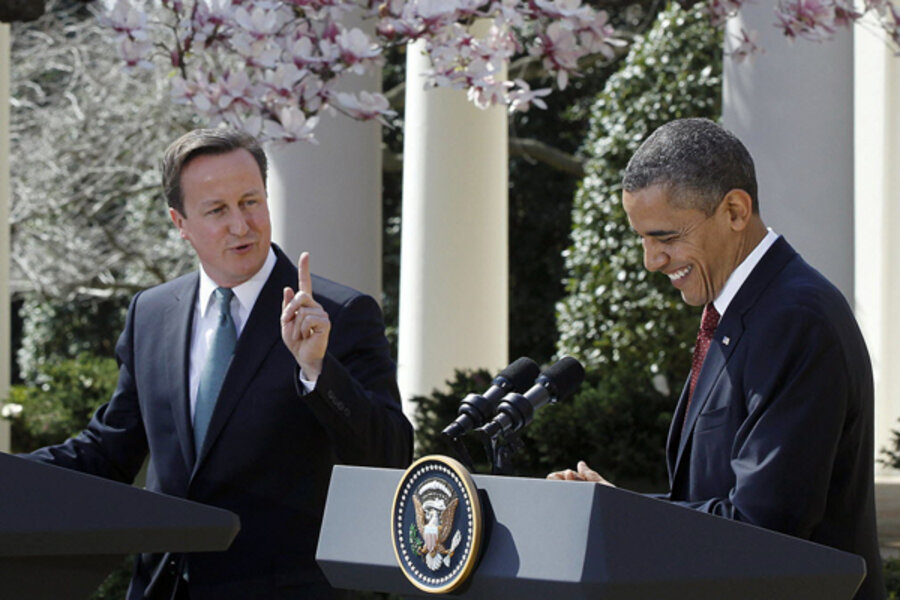Obama, Cameron tout Afghanistan exit plan, but will Afghan troops be ready?
Loading...
| Washington
US and NATO troops in Afghanistan will be “shifting to a support role in 2013, in advance of Afghans taking full responsibility” for the country’s security in 2014, President Obama and Prime Minister David Cameron of Britain announced Wednesday in the Rose Garden.
Some argue that such a move – US defense officials say ideally by the middle of 2013 – is long overdue. But is there any indication that Afghan troops are ready and able to handle security throughout the country come next year?
Although US forces have been at war in the country for a decade, training Afghan troops has been a notoriously slow-going process, as US military commanders routinely acknowledge.
Today, the training effort is at the heart of the Pentagon’s strategy on the ground. Get Afghan soldiers and police ready to defend their country, so that US troops can leave, the reasoning goes.
In the past 18 months, the uniformed ranks of the Afghan national security forces have doubled to some 300,000. Yet, according to a January assessment by the Director of National intelligence (DNI), these troops rely on US and NATO forces in order to operate. “In terms of security, we judge that the Afghan police and Army will continue to depend on ISAF [International Security Assistance Force] support.”
What’s more, sheer size does not necessarily equal quality. “Will they be at the standard that we have for our soldiers?” asked Lt. Gen. Curtis Scaparrotti, commander of the ISAF Joint Command, at a Pentagon press briefing in February. “No. Not, at least, the conventional force.”
While many might argue that few soldiers in the world are up to the standards of US troops, the problem is how few Afghan soldiers – even after years of US training – can currently operate independently of their NATO military mentors.
Indeed, those figures remain “very low,” Scaparrotti conceded in his briefing. In total, the number of Afghan kandaks, or Army battalions, that can currently operate “independent with advisers” is 29.
That represents approximately one percent of the total Afghan security force ranks, Scaparrotti noted.
In the US military’s next assessment ranking, “effective with advisers,” the news is a bit brighter. Some 42 percent of Afghan units may plan and execute missions, but they also rely on the air, fire, and logistical support of US troops to do it.
Afghan troops are “in the lead” for just under a third of the missions they conduct, meaning that they rely on US forces as “enablers,” providing vital equipment and advice.
“We do have a number of forces now that are stepping out into the lead, choosing to do their own planning, informing our forces, and going out. So it’s building,” Scaparrotti said. “But I would say it’s [in its] early stages, to be frank with you.”
At a certain point, though, it’s clear that US troops will have to simply remove the “training wheels,” say senior US defense officials.
“The Afghans, if they see Americans moving forward, may have a tendency to step back,” Michael Sheehan, assistant secretary of Defense for Special Operations, said at a Washington conference in February. “In my view that’s got to be the most important aspect of the transition – having US forces take a step back and the Afghan security forces take a step forward.”
And with 23,000 US troops set to leave Afghanistan between now and the end of September, it’s clear that NATO trainers will have to step up the pace, say analysts.
Just how much they can do before Afghan troops are set to assume full responsibility for security in the country in 2014 remains to be seen, officials acknowledge.
For his part Mr. Cameron, Mr. Obama’s closest ally in the Afghanistan war, ventured a tentative, and notably measured, assessment in the Rose Garden.
“Do I think we can get to a situation by the end of 2014 where we have a larger Afghan National Army, a larger Afghan police force, both of which are pretty much on track and ... capable of taking care of their own security in a way that doesn’t require large numbers of foreign troops?” he asked. “Yes, I think we can achieve that.”





